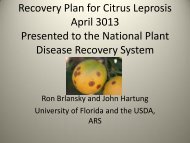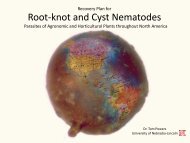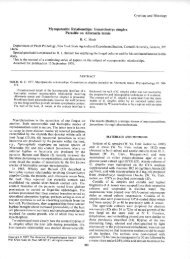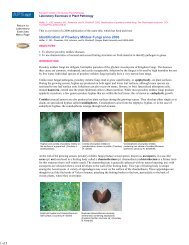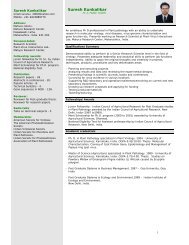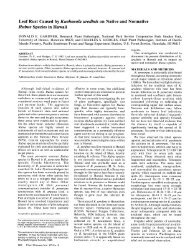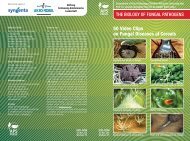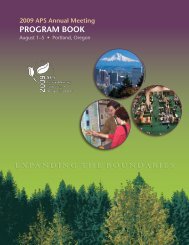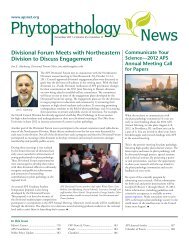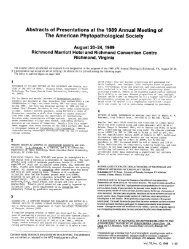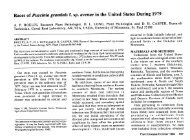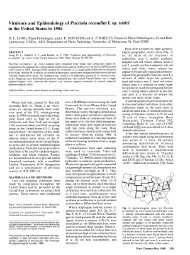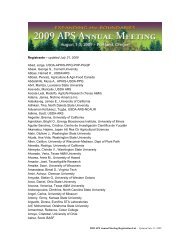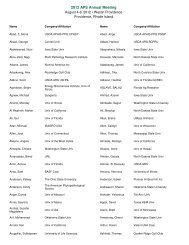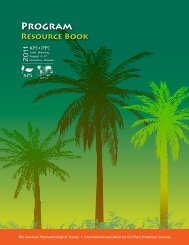See the program book (PDF) - American Phytopathological Society
See the program book (PDF) - American Phytopathological Society
See the program book (PDF) - American Phytopathological Society
You also want an ePaper? Increase the reach of your titles
YUMPU automatically turns print PDFs into web optimized ePapers that Google loves.
tueSDAy<br />
SeSSiOnS – tuesday, Flash-and-Dash & Special<br />
10:40 a.m. P-756 A holistic approach to control potato late<br />
blight in organic production system in Parana,<br />
Brazil. N. NAZARENO (2), A. S. Pereira (1), C.<br />
B. Medeiros (1). (1) Embrapa, Pelotas, RS, Brazil,<br />
(2) IAPAR, Curitiba, PR, Brazil<br />
Professional<br />
10:00 – 10:25 a.m. * 211 CD<br />
Moderator: Michael J. Boehm, Ohio State University,<br />
Columbus, OH<br />
10:00 a.m. P-763 New Pest Advisory Group: Assessing exotic<br />
plant pathogens and pests recently introduced or<br />
imminently threatening <strong>the</strong> United States. K. A.<br />
SCHWARTZBURG (1), K. E. Colpetzer (1), B.<br />
M. Spears (1). (1) USDA APHIS PPQ Center for<br />
Plant Health Science and Technology (CPHST),<br />
Raleigh, NC, U.S.A.<br />
10:05 a.m. P-784 Does our teaching impact <strong>the</strong> affective<br />
domain of our students? C. J. D’ARCY (1),<br />
D. M. Eastburn (1). (1) University of Illinois,<br />
Urbana, IL, U.S.A.<br />
10:10 a.m. P-785 “Taking it home” – a project to assess<br />
student use of class material. D. M. EASTBURN<br />
(1), C. J. D’Arcy (1). (1) University of Illinois,<br />
Urbana, IL, U.S.A.<br />
10:15 a.m. P-775 Developing a fungicide resistance<br />
management guide for vegetable crops grown in<br />
<strong>the</strong> mid-Atlantic region. C. A. WYENANDT<br />
(4), K. L. Everts (3), R. L. Mulrooney (1),<br />
S. L. Rideout (2), N. L. Maxwell (4). (1)<br />
Dept. of Plant & Soil Sciences, University of<br />
Delaware, Newark, DE, U.S.A., (2) Dept. of<br />
Plant Pathology, Physiology and Weed Sciences,<br />
Virginia Polytechnic Inst., ESAREC, Painter, VA,<br />
U.S.A., (3) Dept. of Plant Sciences & Landscape<br />
Architecture, University of Maryland, Lower<br />
Eastern Shore Res. & Ed. Center, Salisbury,<br />
MD, U.S.A., (4) Rutgers University, New Jersey<br />
Agricultural Experiment Station, Bridgeton, NJ,<br />
U.S.A.<br />
10:20 a.m. P-111 A summary of diagnostics conducted by<br />
<strong>the</strong> USDA-APHIS-PPQ Molecular Diagnostic<br />
Laboratory. P. SUDARSHANA (2), R. Shukla<br />
(2), G. Abad (2), B. R. Olson (1), M. Palm (2).<br />
(1) Oklahoma State University, Stillwater, OK,<br />
U.S.A., (2) USDA-APHIS-PPQ, Beltsville, MD,<br />
U.S.A.<br />
54<br />
tuesday Afternoon Special Sessions<br />
Assembling <strong>the</strong> Fungal Tree of Life: From Linnaeus to Deep<br />
Hypha and Beyond<br />
1:00 – 4:00 p.m. * 200 HIJ<br />
Section: Biology of Pathogens<br />
Organizer/Moderator: Carol Stiles, University of Florida,<br />
Gainesville, FL<br />
Sponsoring Committees: Mycology, Teaching, Diagnostics,<br />
Early Career Professionals<br />
Invited speakers will include mycological systematists from<br />
<strong>the</strong> Deep Hypha Research Coordination Network who are<br />
involved in “Assembling <strong>the</strong> Fungal Tree of Life” (AFTOL).<br />
The resulting phylogeny will have a major impact on future<br />
text<strong>book</strong>s and research, as well as plant pathology, because<br />
resolving <strong>the</strong> phylogenetic relationships among fungi provides<br />
information about biology and management of fungal plant<br />
diseases.<br />
1:00 p.m. S-73. Fungal phylogeny: It takes a community.<br />
M. BLACKWELL (1). (1) Louisiana State<br />
University, Baton Rouge, LA, U.S.A.<br />
1:30 p.m. S-74. Importance of subcellular structure in<br />
fungal phylogeny. D. MCLAUGHLIN (1). (1)<br />
University of Minnesota, St. Paul, MN, U.S.A.<br />
2:00 p.m. S-75. The Ascomycota. C. SCHOCH (1),<br />
B. Robbertse (1), and J. W. Spatafora (1). (1)<br />
Oregon State University, Corvallis, OR, U.S.A.<br />
2:30 p.m. S-76. The Basidiomycota. M. C. AIME (1). (1)<br />
Louisiana State University, Baton Rouge, LA,<br />
U.S.A.<br />
3:00 p.m. S-77. The Oomycota. C.A. LÉVESQUE (1),<br />
A.W.A.M. de Cock (2), G. Robideau (1), N.<br />
Desaulniers (1), K. Bala (1). (1) Agriculture and<br />
Agri-Food Canada, Ottawa, ON, Canada; (2)<br />
Centraalbureau voor Schimmelcultures, Utrecht,<br />
The Ne<strong>the</strong>rlands<br />
3:30 p.m. Future impact of phylogeny for plant disease<br />
management, panel<br />
Balancing Natural and Augmentative Biocontrol in<br />
Organic Cropping Systems<br />
1:00 – 2:30 p.m. * 205 AB<br />
Section: Plant Disease Management<br />
Organizer/Moderator: Brian McSpadden Gardener, The<br />
Ohio State University-OARDC, Wooster, OH<br />
Sponsoring Committees: Biological Control<br />
A moderated open-forum discussion session (not a<br />
symposium). Moderator and participants will address<br />
questions such as: To what extent do organic farmers currently<br />
depend on cover crops, composts, and green manures<br />
to enhance natural biocontrol? What fraction of organic<br />
growers are turning to biopesticidal inoculants? Under<br />
what circumstances are inoculants and o<strong>the</strong>r augmentative<br />
biocontrol strategies being used? Can we define <strong>the</strong> conditions<br />
under which natural biocontrol processes must be augmented



